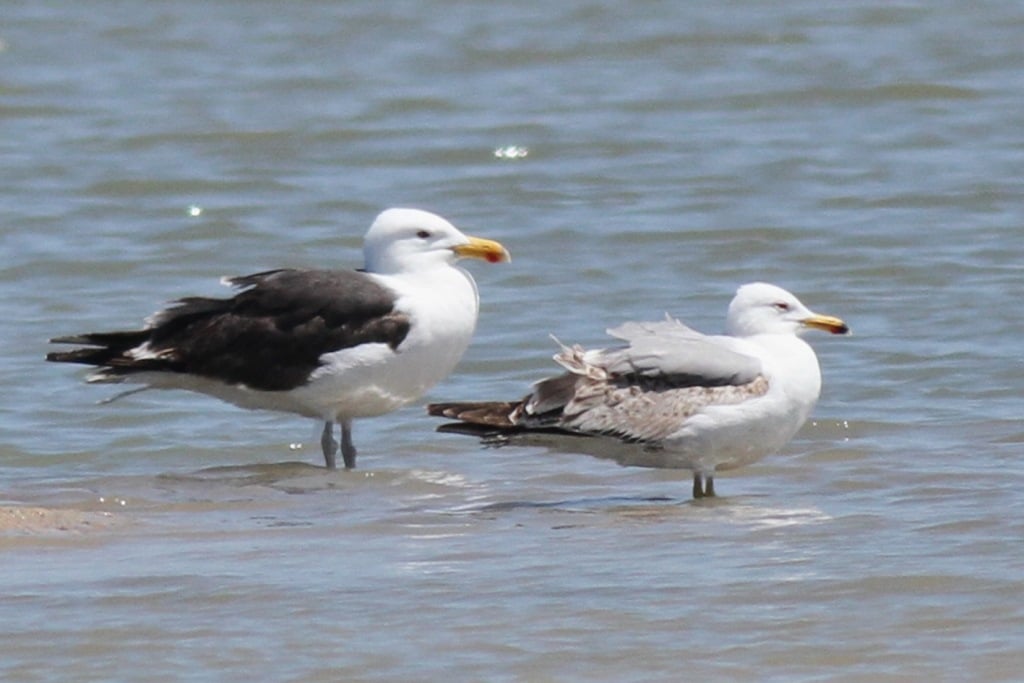The 25th report of the Moroccan Rare Birds Committee (MRBC) was published about three months ago. In 2019, the MRBC examined 71 new records, of which 58 were accepted.
It should be noted that 2019 was a very “slow” year in comparison with the last five years where the number of examined records ranged between 109 and 168 (and the number of accepted ones ranged between 92 and 157).
Probably because of this, there was only one addition to the Moroccan birds’ list: Hume’s Leaf Warbler (Phylloscopus humei).
There is also the first accepted record of the Great Black-backed Gull x Kelp Gull (Larus marinus x Larus dominicanus). This hybrid bird was observed at Oualidia wetland, but we can safely assume that it originated from Khnifiss Lagoon where both parent species co-occur. Some observations of presumed hybrids in the Khnifiss Lagoon have been reported in the past, but probably have never been submitted to the MRBC (See photos of some of these presumed hybrids in updates 2 and 3 in this blog-post: Status of Kelp Gull in Morocco).

The report also included the 2nd of Isabelline Shrike (Lanius isabellinus), the 6th of both Brown Booby (Sula leucogaster) and Baltic Lesser Black-backed Gull (Larus fuscus fuscus), the 8th Citrine Wagtail (Motacilla citreola), the 10th Franklin’s Gull (Leucophaeus pipixcan), the 11th of both White-fronted Goose (Anser albifrons) and Long-billed Dowitcher (Limnodromus scolopaceus), the 12th Namaqua Dove (Oena capensis), the 13th of both Golden Nightjar (Caprimulgus eximius) and Monk Parakeet (Myiopsitta monachus).
Other noteworthy records includes the 15th Lesser Flamingo (Phoeniconaias minor), the 17th Balearic Woodchat Shrike (Lanius senator badius), the 19th to 24th Yellow-browed Warbler (Phylloscopus inornatus), the 22nd and 23rd Richard’s Pipit (Anthus richardi), the 23rd Golden Sparrow (Passer luteus), the 23rd to 25th Kelp Gull (Larus dominicanus), the 27th to 31st Blue-winged Teal (Spatula discors) and the 30th Cinereous Vulture (Aegypius monachus).
Full report:
Fareh, M., Maire, B., Laïdi, K., Ennoury, A., Rousselon, K., Franchimont, J. & CHM. 2020. Les oiseaux rares au Maroc. Rapport de la Commission d’Homologation Marocaine numéro 25. Go-South Bulletin 17: 104-120.
When numbering records in English remember that records one, two and three and the first, second and third records, are written 1st, 2nd and 3rd as abbreviations. Records four onwards are written 4th, 5th, 6th as far as the 20th. Thereafter, records whose numbers end in one, two or three are written 21st, 22nd, 23rd, 31st, 32nd, 33rd etc. All others are written with a th e.g. 55th, 77th, 99th.
Sorry about all this. I didn’t invent the rules.
Hi Ernest,
Thank you so much for reading and taking the time to comment on these mistakes. And please do not say sorry for doing so.
Although I am a member of the MRBC, I am not one of the authors who produced the report (and didn’t see it until it was published). When I shared the report in this blog, I essentially copy-pasted the abstract from the original without changes (except the text above the photo). Of course, I fully recognise that this is not an excuse to copy-past obvious errors like those you pointed out.
I will let our secretary know about these errors because that’s not the first time they made them in recent reports (e.g. in the 23rd and 24th reports).
Thanks again!
Mohamed